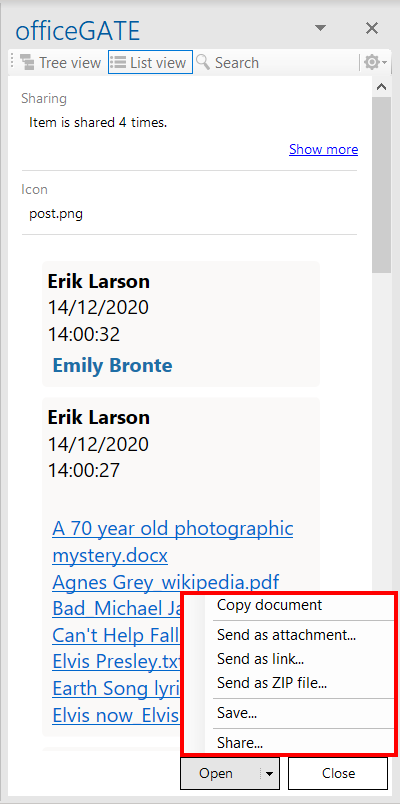8.2.View selection: Tree view, List view, Collapse all
There are 3 main views available in the officeGATE’s status pane:
- Tree view (Screenshot A);
- List view (Screenshot B)
- and Collapse all (Screenshot C).
The user may also switch between tree view and list view with a middle-mouse click if this option is enabled in the General settings of officeGATE (read more in section General officeGATE settings).

A) Tree view [ ]: This view displays all available providers and presents a hierarchical view of information. Each provider in the Tree view has several child nodes (a child node can either be a folder in a local or cloud file provider, a library or folder in SharePoint, or a plugin in contentACCESS). A provider can be expanded to reveal child nodes, and collapsed to hide them. To expand a provider, click on plus sign “+” and locate the child node that you want to work with. With a right-click on the child node you may open its context menu. The context menu options depend on the particular provider.
]: This view displays all available providers and presents a hierarchical view of information. Each provider in the Tree view has several child nodes (a child node can either be a folder in a local or cloud file provider, a library or folder in SharePoint, or a plugin in contentACCESS). A provider can be expanded to reveal child nodes, and collapsed to hide them. To expand a provider, click on plus sign “+” and locate the child node that you want to work with. With a right-click on the child node you may open its context menu. The context menu options depend on the particular provider.
The user can add the selected child to the list of favorites, rename, delete, open selected folders, create new subfolders from the context menu directly, or upload new files into it. The first table of chapter Working with nodes and files using the context menu gives an overview for the user about the nodes’ context menu options that are available in the respective officeGATE providers.
With the  Collapse all option you can collapse the nodes that have been previously opened in the Tree view mode (Screenshot C above).
Collapse all option you can collapse the nodes that have been previously opened in the Tree view mode (Screenshot C above).
B) List view [ ]: In this view the contents (folders, documents, etc.) of the selected parent folder are listed. The topmost entry is displayed as “..” and links to the parent location when it’s clicked. In List view, at the bottom of the pane you can also see the path (breadcrumbs) where a certain document is located in your file system. The user can click on a breadcrumb element to easily navigate to a parent location.
]: In this view the contents (folders, documents, etc.) of the selected parent folder are listed. The topmost entry is displayed as “..” and links to the parent location when it’s clicked. In List view, at the bottom of the pane you can also see the path (breadcrumbs) where a certain document is located in your file system. The user can click on a breadcrumb element to easily navigate to a parent location.
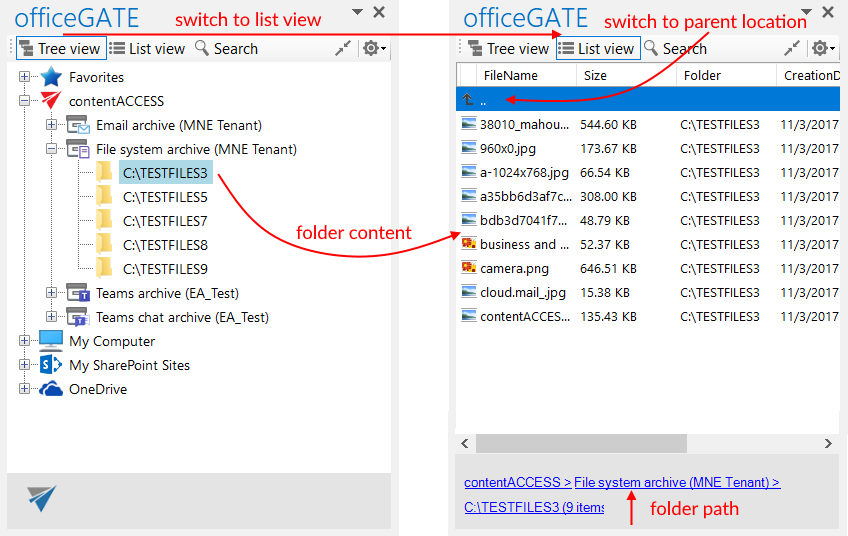
Sorting in List view
officeGATE enables sorting the items based on column headers in the list view. If you choose a different provider, then different headers are displayed. In our illustrative screenshot below a SharePoint folder is chosen, where the files can be sorted by 3 column headers (sorting criteria), namely: Name, Modified and Modified by. In the second picture the files are sorted by the date when they were last modified.
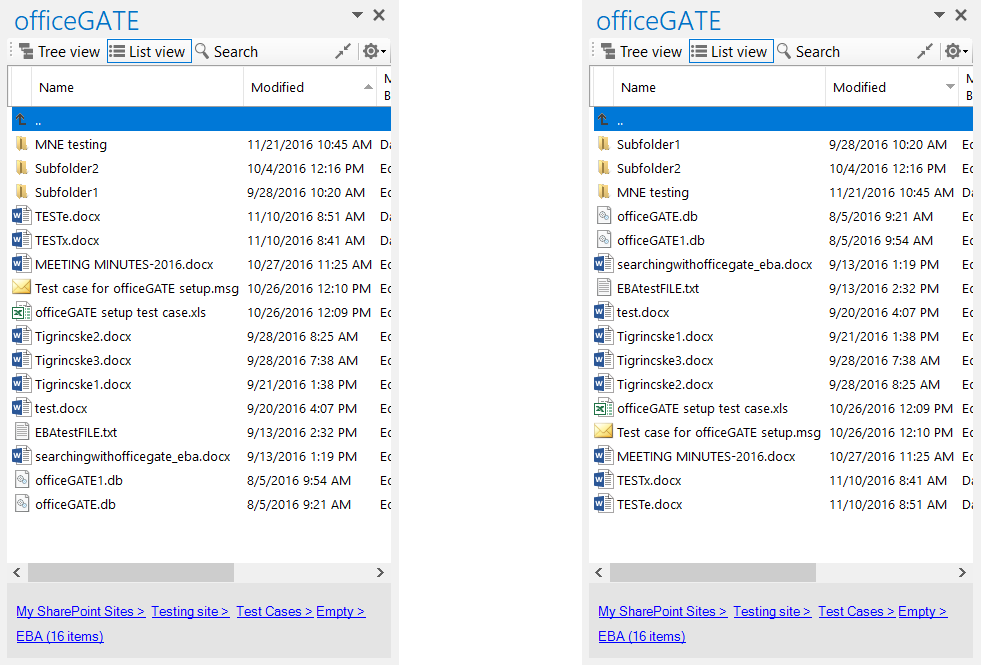
Double-click on contentACCESS items in List view
When you are in list view and double-click on a contentCCESS item, its preview opens (the context menu option Properties works the same).
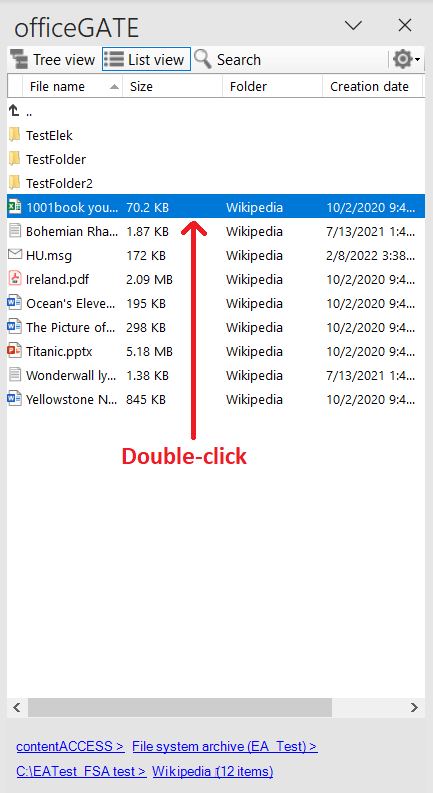
If the Preview service is installed (and enabled in the Central Administration) with the package, the user can view the file’s preview in officeGATE.
The Preview service works with:
- the attachments of the emails (from Email archive and GDPR Exchange) and teams messages (Teams archive)
- the files from File System, OneDrive, and SharePoint archive, GDPR File system, and Teams archive (Files folder) models
- the previous versions of the items from the file-based models
When the Preview service is enabled, it’s accessible from the file’s icon or the context menu.
Click on the file’s icon
If you open a preview for the first time (or after the login session is expired), the login page appears. Here, you need to choose a login method.
After the login, the item’s preview appears. Here, the following options are available:
- 1. Back – you can go back to the item’s preview where the metadata is displayed
- 2. Save – the user can save the file to his device
- 3. View in browser – opens the file in a browser, and the user can either download the original file or as a PDF
- 4. Open – opens the file in the designated application
![]()
Context menu
The following functions are available from here:
- View – opens the preview (Save and View in browser options displayed here)
- View in browser – opens the preview in the browser – download the original file or as PDF
- Open – opens the file in the designated application
- Save – saves the file to the local machine
- Copy – copies the document to the clipboard
- Send as attachment – attaches the file to a new email and sends it to the selected recipients
- Send as ZIP – sends the file as ZIP file to the selected participants
- Share – shares the selected file from the preview
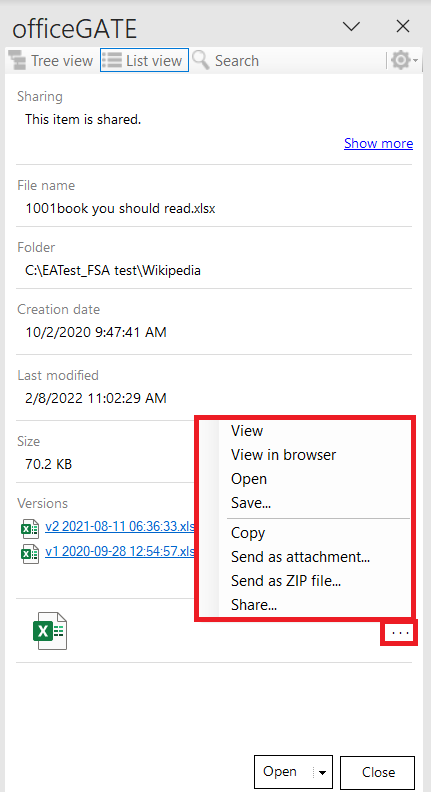
From this preview, it is possible to Open the original item or Close the preview.
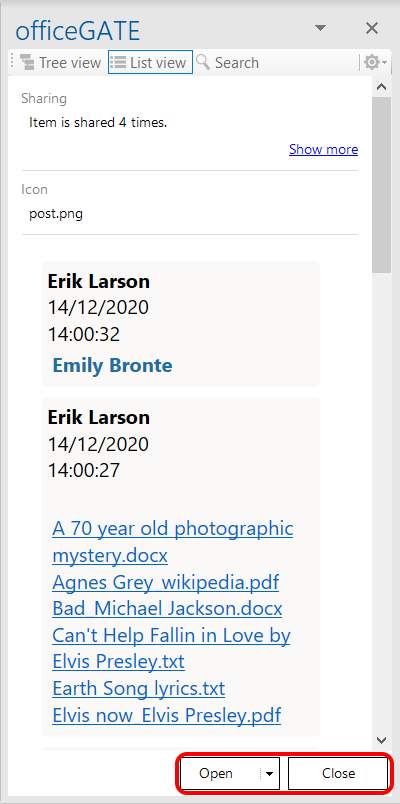
If you click on the little arrow on the Open button, the following options for the item appear:
- Copy document
- Send as attachment…
- Send as link…
- Send as ZIP file…
- Save…
- Share…
